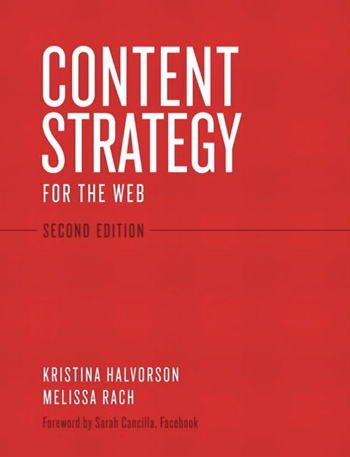 Content strategy has increasingly become a part of the web design conversation and in large part due to Kristina Halvorson, who has become a noted content advocate and activist.
Kristina is the founder and president of Brain Traffic, an agency specializing in content strategy and writing for the web, author of the groundbreaking book, Content Strategy for the Web, and a frequent speaker at web design conferences worldwide. Over the past months, she and co-author, Melissa Rach, have been hard at work on the second edition of the book which is due out on New Riders in February 2012.
Kristina took time out of her busy schedule to talk with us about the evolving world of content strategy.
We thank Kristina for this insightful interview and invite WDD readers to join in the content strategy conversation.
In your article, "Content Strategy and UX: A Modern Love Story," you wrote, "What's important is that we [content strategists and UX strategists] are all are able to talk about shared principles; this is where the foundation for our collaboration truly lies." What is your prescription for how content strategists and UX strategists should work together?
Content planning needs to be a part of the mindset of the web project and we need to start thinking about content from day one. We need to ask the right questions: what content do we need, what content do we have already, where does it live, who owns it, and who’s going to take care of it?
Design has to match the content, and content has to match the design. Content will define design choices and designers have been asking for the right content all along. There’s the messaging component—what are users showing up for, what are they looking for? We need to prioritize the content elements so we stay on brand, up-to-date, and have a shared language between content and design.
Content strategy has increasingly become a part of the web design conversation and in large part due to Kristina Halvorson, who has become a noted content advocate and activist.
Kristina is the founder and president of Brain Traffic, an agency specializing in content strategy and writing for the web, author of the groundbreaking book, Content Strategy for the Web, and a frequent speaker at web design conferences worldwide. Over the past months, she and co-author, Melissa Rach, have been hard at work on the second edition of the book which is due out on New Riders in February 2012.
Kristina took time out of her busy schedule to talk with us about the evolving world of content strategy.
We thank Kristina for this insightful interview and invite WDD readers to join in the content strategy conversation.
In your article, "Content Strategy and UX: A Modern Love Story," you wrote, "What's important is that we [content strategists and UX strategists] are all are able to talk about shared principles; this is where the foundation for our collaboration truly lies." What is your prescription for how content strategists and UX strategists should work together?
Content planning needs to be a part of the mindset of the web project and we need to start thinking about content from day one. We need to ask the right questions: what content do we need, what content do we have already, where does it live, who owns it, and who’s going to take care of it?
Design has to match the content, and content has to match the design. Content will define design choices and designers have been asking for the right content all along. There’s the messaging component—what are users showing up for, what are they looking for? We need to prioritize the content elements so we stay on brand, up-to-date, and have a shared language between content and design.
 The second edition of your book, Content Strategy for the Web is due out shortly. What are the major differences you've seen in content strategy from the publication of the first edition to the second?
The second edition of your book, Content Strategy for the Web is due out shortly. What are the major differences you've seen in content strategy from the publication of the first edition to the second?
Debbie Hemley
Debbie is a blogger and social media aficionado. She works with businesses to develop content and social media strategies. Read her blog posts on All the News. You can also follow Debbie @dhemley and on Google+.
Read Next
3 Essential Design Trends, May 2024
Integrated navigation elements, interactive typography, and digital overprints are three website design trends making…
20 Best New Websites, April 2024
Welcome to our sites of the month for April. With some websites, the details make all the difference, while in others,…
Exciting New Tools for Designers, April 2024
Welcome to our April tools collection. There are no practical jokes here, just practical gadgets, services, and apps to…
14 Top UX Tools for Designers in 2024
User Experience (UX) is one of the most important fields of design, so it should come as no surprise that there are a…
By Simon Sterne
What Negative Effects Does a Bad Website Design Have On My Business?
Consumer expectations for a responsive, immersive, and visually appealing website experience have never been higher. In…
10+ Best Resources & Tools for Web Designers (2024 update)
Is searching for the best web design tools to suit your needs akin to having a recurring bad dream? Does each…
By WDD Staff
3 Essential Design Trends, April 2024
Ready to jump into some amazing new design ideas for Spring? Our roundup has everything from UX to color trends…
How to Plan Your First Successful Website
Planning a new website can be exciting and — if you’re anything like me — a little daunting. Whether you’re an…
By Simon Sterne
15 Best New Fonts, March 2024
Welcome to March’s edition of our roundup of the best new fonts for designers. This month’s compilation includes…
By Ben Moss
LimeWire Developer APIs Herald a New Era of AI Integration
Generative AI is a fascinating technology. Far from the design killer some people feared, it is an empowering and…
By WDD Staff
20 Best New Websites, March 2024
Welcome to our pick of sites for March. This month’s collection tends towards the simple and clean, which goes to show…
Exciting New Tools for Designers, March 2024
The fast-paced world of design never stops turning, and staying ahead of the curve is essential for creatives. As…















